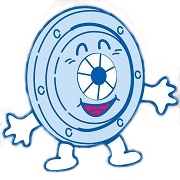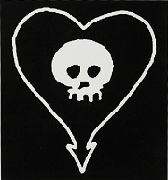|
LloydDobler posted:What I love about this is that it means at 5252 RPM horsepower and torque are equal. On all dyno graphs the torque and power curves touch or cross at 5252. Unless the person graphing is a dick who uses a different scale for HP and lbft.
|
|
|
|

|
| # ? Apr 26, 2024 09:30 |
|
Fucknag posted:E: And if you have an engine that outputs these forces, the same is true of the load it can move. 200 lb*ft turning a 1-foot radius wheel? That can exert a force of 200 lbs at the rim. Put the same engine behind a 4:1 gear reduction, and now it's exerting 800 lb of force at the same wheel rim, but more slowly. how does this work out for final drive ratios? I know that either a higher or lower ratio is more desirable in a fast car than the other, but no idea which or why.
|
|
|
|
atomicthumbs posted:how does this work out for final drive ratios? I know that either a higher or lower ratio is more desirable in a fast car than the other, but no idea which or why. High gearing for drag racing/short autocross-scale courses (quickest acceleration), lower gearing for track racing and top speed trials (highest top speed).
|
|
|
|
Fucknag posted:High gearing for drag racing/short autocross-scale courses (quickest acceleration), lower gearing for track racing and top speed trials (highest top speed). Higher numerically for drag racing. Lower numerically for top speed. When people talk about gears though lower gears are numerically higher and vise versa.
|
|
|
|
It depends on what you're using the car to do. It's the same basic principle - a numerically higher gear ratio (say, 4.88:1) in the final drive will allow an otherwise identical car to accelerate more quickly than with a numerically lower gear ratio (2.73:1). But, as with all things, it's a compromise. Since you have a finite number of gears in the transmission, and you typically can't do much to change their ratios, changing the final drive will often impact the top speed. In a more real-world situation, it will also usually impact fuel mileage / highway drivability. You can also go too far on the low end. If your car is already severely traction limited and already has a very numerically high first gear, a higher final drive can just make it harder to get traction / make you shift out of first almost immediately.
|
|
|
|
obviously the solution here is a manual transmission with a smoothly actuating lever next to it for the continuously variable differential 
|
|
|
|
Bajaha posted:The torque isn't defined at a particular distance. Given a value for torque you can calculate the force the motor can exert at a particular distance or the distance required to exert a particular force. You can also work the other way and find the torque for given values of force and distance. Taking this one step further into the automotive realm, you can apply this directly to the acceleration of your car in any gear. Take the tire width and divide it by total drive ratio (gear ratio * final drive ratio) to get the effective lever length of your car's entire powertrain. The torque output of your engine multiplied by this ratio gives you the acceleration of the car (this is idealized, real world has a bunch of limiting factors and inefficiency)
|
|
|
|
The more precise you want to be, the more complicated things get!
|
|
|
|
IOwnCalculus posted:It depends on what you're using the car to do. It's the same basic principle - a numerically higher gear ratio (say, 4.88:1) in the final drive will allow an otherwise identical car to accelerate more quickly than with a numerically lower gear ratio (2.73:1). But, as with all things, it's a compromise. 4.88:1 is getting into rock crawler territory (though I suppose dedicated dragsters would be similarly geared), standard low-gear final drive for street cars is 3.27:1-ish, maybe 3.55:1 and a limited-slip diff for a cop car launching out of its hiding spot on the median to chase down a speeder. 2.73:1 is the norm for granny cars/driving appliances, because it gives better gas mileage. Crap for acceleration, though. There's one place on a route I regularly take where a small road crosses a 5-lane US Highway -- with the '84 grandma-spec Crown Vic, I had to wait for a big gap and trundle across; with the cop car, I have to tap the brakes once I'm across the highway to keep it under 40. Also, fun fact, related to the earlier discussion of torque vs. horsepower: Ford changed the composition of the driveshaft of the Crown Vic for '04, and installed a rev limiter. The reason for the limiter was torque, not speed -- you'd expect it was because the shaft would fly apart at 130+mph, but it's actually because it'd twist. (I have an '03 with the fancy driveshaft, but I doubt it'd peg the speedometer because it has the low-gear rearend, it'll run out of engine before it runs out of speedometer.) MarsellusWallace posted:Take the tire width Edit: what's the rule on speedometer accuracy? My mom's Kia reads 5mph under at highway speeds, according to GPS. Is that just poor tolerances, or helping you avoid speeding tickets? Mine, of course, is spot-on, because cop car. So when I get pulled over, the cop doesn't ask "do you know how fast you were going?", he just shakes his head. And then I usually get off with a warning because I get him into a discussion of the relative merits of the Ford vs. the new Dodge! 
Chillbro Baggins fucked around with this message at 05:09 on Dec 4, 2014 |
|
|
|
Delivery McGee posted:Also, fun fact, related to the earlier discussion of torque vs. horsepower: Ford changed the composition of the driveshaft of the Crown Vic for '04, and installed a rev limiter. The reason for the limiter was torque, not speed -- you'd expect it was because the shaft would fly apart at 130+mph, but it's actually because it'd twist. That doesn't really make sense to me since the engine makes way more torque at 4k rpm than it does at 6k.
|
|
|
|
Delivery McGee posted:4.88:1 is getting into rock crawler territory (though I suppose dedicated dragsters would be similarly geared), standard low-gear final drive for street cars is 3.27:1-ish, maybe 3.55:1 and a limited-slip diff for a cop car launching out of its hiding spot on the median to chase down a speeder. 2.73:1 is the norm for granny cars/driving appliances, because it gives better gas mileage. Crap for acceleration, though. There's one place on a route I regularly take where a small road crosses a 5-lane US Highway -- with the '84 grandma-spec Crown Vic, I had to wait for a big gap and trundle across; with the cop car, I have to tap the brakes once I'm across the highway to keep it under 40. This used to be the case (at least on the tall side) but with modern 6+ speed gearboxes, it's not really true anymore. Six-speed automatic Corvettes (C6 and C7) have rear ends in the 2.5x-2.7x range because first gear in the 6L80E is 4:1 and sixth is 0.67:1. With the new-for-2015 8L90 eight-speed, the C7 Z06 and base C7 get a 2.41:1 rear end ratio... because first is 4.56:1. I don't know of anyone going the other way with tall transmission ratios and a super-short final drive, though. So high-4/low-5:1 final drives are still mostly the realm of drag racers (where you just want to maximize speed over 1/4 of a mile) and rock crawlers (where you want to maximize torque at the lowest speeds possible).
|
|
|
|
Part of the tall final drive is top speed bragging rights, plus of course being able to drive down the highway at 1800rpm. If I had enough power my car would only go 150 with its 4.11 diffs and the engine is at something like 3600 at 80.
jamal fucked around with this message at 06:30 on Dec 4, 2014 |
|
|
|
Underpowered, heavy vehicles will also often see shorter ratios. My Sportage has 4.78:1 diffs, and with the 31s I put on even those are a bit tall- 5th gear is basically useless to me since it puts the engine significantly below the powerband, I quickly lose speed and have to drop back into 4th.
|
|
|
|
IOwnCalculus posted:I don't know of anyone going the other way with tall transmission ratios and a super-short final drive, though. I imagine that's because then the driveshaft is spinning faster for any given wheel speed. Ask that guy who took the limiter off his V6 Mustang how that works out.
|
|
|
|
jamal posted:That doesn't really make sense to me since the engine makes way more torque at 4k rpm than it does at 6k. Also the 4.6 wasn't a torque monster. It made around 280ft-lbs I think?
|
|
|
|
jamal posted:That doesn't really make sense to me since the engine makes way more torque at 4k rpm than it does at 6k. If I was to guess I would say that at an engine speed of 6000RPM these some coupled natural frequency/low stability of twisting and bending. The combined vibration with the persistent torque in one direction is probably what kills it. This is just a shot in the dark possibility though.
|
|
|
|
Would a 4 cylinder, v6, and v8 all have the same amount of power if the displacement was the same? Like what are the reasons for choosing one type over the others?
|
|
|
|
SperginMcBadposter posted:Would a 4 cylinder, v6, and v8 all have the same amount of power if the displacement was the same? Like what are the reasons for choosing one type over the others? More cylinders = more combustion strokes to deliver your power which means a smoother running engine because the power strokes overlap each other. V configurations are beneficial for packaging reasons and because a shorter crankshaft means that there is less longitudinal force applied to the shaft, which means you can spin faster without the whole thing shaking itself apart. It's why you don't see inline 8 engines at all anymore, and most manufacturers have transitioned away from inline 6 engines as well. This is really a high level explanation that barely scratches the surface of engine design, I'm sure someone like kastein can chime in with more details that I would probably get wrong
|
|
|
|
Tommychu posted:Underpowered, heavy vehicles will also often see shorter ratios. My Sportage has 4.78:1 diffs, and with the 31s I put on even those are a bit tall- 5th gear is basically useless to me since it puts the engine significantly below the powerband, I quickly lose speed and have to drop back into 4th. My Miata is about to have the R&P from the front of a Sportage 4x4.  Don't know why it's faster but people who know what's up said it's faster. Don't know why it's faster but people who know what's up said it's faster.w/r/t autocross gearing. It's usually about maximizing your speed in 2nd (or 3rd on some cars) gear. Once I put the 4.77 rear end in my Miata it's going to be an abysmal autocross car since 2nd gear will top out at 56mph. FatCow fucked around with this message at 20:17 on Dec 6, 2014 |
|
|
|
SperginMcBadposter posted:Would a 4 cylinder, v6, and v8 all have the same amount of power if the displacement was the same? Like what are the reasons for choosing one type over the others? Cylinder displacement depends on bore and stroke. Roughly, the displacement imposes a limit for the maximum torque of the engine and the power generated by the engine is proportional to the engine speed. To produce as much power as possible, the goal should be to produce as much torque as possible at highest possible rpm. In professionally designed racing engines without artificial limitations (inlet restrictors, compulsory components, etc.) the engine power output is determined by displacement and maximum revs (see maximum rev limits in different racing leagues). As the stroke is increased, the acceleration of the piston at a given rpm increases. Thus, the increased stoke requires stronger components or imposes a lower maximum rpm. As the bore is increased, the combustion chamber becomes flatter: it takes longer for the flame front to travel across the combustion chamber, efficient scavenging becomes more difficult and it is more difficult to maintain uniform mixture in the combustion chamber. This can lead to detonation, incomplete combustion, increased emissions and limits maximum rpm. Bores above As a result, increased cylinder displacement leads to a lower usable rev range. It appears that cylinder displacement in 400-700 cc range is a popular choice in passenger cars. In high revving sports motorcycles cylinder displacement tends to be in 200-300 cc range. In power generation and naval applications huge cylinder displacements are used, but these are very slow rpm engines. DoLittle fucked around with this message at 00:52 on Dec 7, 2014 |
|
|
|
CommieGIR posted:http://auto.howstuffworks.com/automatic-transmission13.htm The first time I opened up an automatic transmission, I thought I was looking at a joke. Seriously the maze with the little balls going through it looked like the mouse trap board game to me.
|
|
|
|
DoLittle posted:Bores above 100 mm are rare in passenger vehicles. I believe an extreme example is the 116 mm bore of a 1285 cc Ducati Panigale. It is nitpicky to say anything but bores over 100mm are pretty common in the 350+CI/5.7+L V8s, but just bumping that number to 110mm is correct.
|
|
|
|
CarForumPoster posted:It is nitpicky to say anything but bores over 100mm are pretty common in the 350+CI/5.7+L V8s, but just bumping that number to 110mm is correct. Yeah, that is correct. The larger cylinder displacements appear as more weight is put on reduction of cost and complexity and less on the specific output. Engines like the LSX have excellent cost/weight/size/output ratios and they are an excellent choice for wide range of applications. I was thinking more in terms of specific output, as the question was phrased in terms of a given displacement. In any case, specific output is a useless optimization goal if there is no need to account for racing, taxation or licensing related classifications. Provided that it doesn't cause other complications, increasing the displacement of a cylinder is much cheaper than increasing number of cylinders as the component count of the engine doesn't change. The Ducati example is also interesting, as I believe that the extremely oversquare design of the Panigale is a choice driven by marketing and not engineering. Ducati want to retain their trademark V-twin and do what they can to remain competitive in the sports bike arena despite it. This is probably the correct business choice and it is interesting to see how far they can hang on to it. However, when Ducati built their 990 cc MotoGP bike they went with a V4, which is quite telling. Edit: Porsche 968/944 S2 has 104 mm bore, Porsche 4.0 flat six 102.7 mm, LS7 104.8 mm. Chevy 409 '61-65' had 109.5 mm bore. What is the largest modern(ish) performance oriented passenger car engine bore? Note that both of the Porsche examples are enlargements of previous smaller engine designs (and Porsche sticks to the flat six like Ducati to the V-twin). DoLittle fucked around with this message at 01:12 on Dec 7, 2014 |
|
|
|
SperginMcBadposter posted:Would a 4 cylinder, v6, and v8 all have the same amount of power if the displacement was the same? Like what are the reasons for choosing one type over the others? There are a huge number of factors at play here. In the real world of streetable automobiles, there are upper and lower bounds on displacement for a given cylinder count. Inline four cylinder engines get a lot of vibrations above 2.5L, but a V8 / V10 / V12 at that displacement would be a lot bigger than the four. The more cylinders you have, you get more firing events during each rotation of the crank. But you have more friction and mass to deal with for more pistons, valves, camshaft lobes, and bearings. It's a balancing (
|
|
|
|
DoLittle posted:Edit: Porsche 968/944 S2 has 104 mm bore, Porsche 4.0 flat six 102.7 mm, LS7 104.8 mm. Chevy 409 '61-65' had 109.5 mm bore. What is the largest modern(ish) performance oriented passenger car engine bore? Note that both of the Porsche examples are enlargements of previous smaller engine designs (and Porsche sticks to the flat six like Ducati to the V-twin). Does this count?: http://www.chevrolet.com/performance/crate-engines/big-block-zz-572-720-r.html 116mm if it does (it doesn't) You picked the ones I would think to check off hand.
|
|
|
|
cursedshitbox posted:E: another one: Definition of torque is trying to piss in the mornings with wood. The hydraulic analogy that is often also used to help people get a feel for voltages and currents in electrical circuits is pretty good and could probably also be used to explain torque, rotation rate (in rpm), and power of motors. Instead of making the analogy to the urethra being supplied by piss from the bladder, we can think of a Gatorade cooler full of water with its top open being fed by rainfall from a heavy rain, and also the Gatorade cooler has not the normal dispenser valve, but maybe something more like a sink faucet valve where you have good control of the water flow. We can talk about having three different valve settings: 1) The valve is just barely open, and so a slight stream of water or even only few drops come out of the valve. However, since the flow out of the cooler is so low and the water level in the cooler is so high, a tremendous pressure is built up in the cooler, and the small amount of water flowing out the cooler comes out with a tremendous force. The pressure buildup in the cooler is analogous to the ability of the motor to generate torque, and the water flow rate is analogous to the rpm. This situation is like having a high torque and a low rpm. 2) The valve is totally open, and the flow of the water out of the cooler is very high. However, now, since the possible flow out of the cooler is higher than the rainfall supplying it, the Gatorade cooler is almost empty, and the water just sort of dribbles out. There isn't a lot of force behind the water flow since there isn't a buildup of pressure in the cooler. This is like having a high rpm but low torque. 3) The valve is partially open, so that you both get a good flow of water out of the cooler and there is a decent amount of pressure build up in the cooler. The amount of power that the water flowing out of the cooler in this configuration could deliver, like to turn a water wheel, is much higher than parts 1) & 2). Although the pressure build-up isn't as high as configuration 1) and the flow rate isn't as high as configuration 2), the product of the two quantities, the power, is the highest of the three for the same rainfall input. This is like having both decent torque and rpm for your particular motor for a certain motor design (cooler size & shape) and fuel & air input (here maybe the amount of rainfall). I'm not that knowledgeable about cars and car engineering, but it's probably safe to assume that a lot of effort in the automobile design goes into making sure that you usually are operating in this region, configuration 3), of good power efficiency of the particular engine (ratio of "available power" from burning air+gas forced into the engine to power delivered to the transmission). Someone who actually is knowledgeable about this, correct me if I'm wrong. silence_kit fucked around with this message at 21:00 on Dec 7, 2014 |
|
|
|
CarForumPoster posted:116mm if it does (it doesn't) It may be based on a production engine family, but...yeah  The largest bore that engine ever had in anything that left the factory as a complete car, is 4.3" for the 454 and Vortec 8100. Looks like the Cadillac 472 and 500 had the same bore too.
|
|
|
|
CarForumPoster posted:If I was to guess I would say that at an engine speed of 6000RPM these some coupled natural frequency/low stability of twisting and bending. The combined vibration with the persistent torque in one direction is probably what kills it. Apparently it's mainly a speed limiter that's triggered by torque. But the aluminum matrix driveshafts just run out of power, the steel-tube ones have a fuel cutout. This is all secondhand from crownvic.net, of course. I haven't managed to rent an airstrip to test my car. I wish I could. I can get out of 10 over by talking cars with the cop, but double the speed limit is "do not pass go, do not collect $200" territory. IOwnCalculus posted:This used to be the case (at least on the tall side) but with modern 6+ speed gearboxes, it's not really true anymore. Six-speed automatic Corvettes (C6 and C7) have rear ends in the 2.5x-2.7x range because first gear in the 6L80E is 4:1 and sixth is 0.67:1. *My cousin once loaned his OJ-era Bronco to his mom, and she thought it was a 3-speed, driving around our hilly downtown. "First gear's a little high," she told him. "Um...that was second, mom." "drat, I'm good." Anybody want to explain automatic transmissions? I would, but I'm too lazy to Photoshop a cutaway view with "torque converter -- DARK MAGIC -- tailshaft". I understand how planetary gears work, at least in theory (a fuckton of needle bearings are involved, I know that from experience). Is there a simple explanation of the analogue hydraulic computer the oilpan's bolted to, or is it best explained as Clarke's "sufficiently advanced technology"?
|
|
|
|
https://www.youtube.com/watch?v=Y1zbE21Pzl0 This gives you a decent basic idea. if you want component descriptions I can post up.. From an engineering standpoint, I love em. they're so complex and touchy feely.
|
|
|
|
CBD posted:The Basics of Bearings Non automotive bearing question. What differs between a low RPM bearing and a high rpm bearing of equivalent size. Like 3-10k RPM vs 70k-150k RPM?
|
|
|
|
Sadi posted:Non automotive bearing question. What differs between a low RPM bearing and a high rpm bearing of equivalent size. Like 3-10k RPM vs 70k-150k RPM? There could be a lot of reasons for this, they're designed different. A seal, type of lubrication, method of preload, type of cage and how theyre mounted, etc. etc.
|
|
|
|
I work as an engine calibration engineer and it's a pretty sweet gig. I don't know what you guys may want to know but I can try and answer some stuff if anybody is interested.
|
|
|
|
Larrymer posted:I work as an engine calibration engineer and it's a pretty sweet gig. I don't know what you guys may want to know but I can try and answer some stuff if anybody is interested. First and foremost, what on earth an engine calibration engineer does. CarForumPoster posted:There could be a lot of reasons for this, they're designed different. A seal, type of lubrication, method of preload, type of cage and how theyre mounted, etc. etc. Well yeah clearly. I was more curious about the specifics. They types of metal, lube, shape of groves and cage, and what factors affect life and the like. I should have been more specific.
|
|
|
|
IOwnCalculus posted:I don't know of anyone going the other way with tall transmission ratios and a super-short final drive, though. So high-4/low-5:1 final drives are still mostly the realm of drag racers (where you just want to maximize speed over 1/4 of a mile) and rock crawlers (where you want to maximize torque at the lowest speeds possible). It happens sometimes in performance-spec versions of economy cars - hot hatches and the like. The standard version gets built with tall gears everywhere for fuel economy, then the performance model gets a shorter final drive because the replacement diff can go in at little extra cost during manufacturing and give you a noticeably stronger kick in the pants. Also, for some reason the Honda Fit has a ridiculously short final drive for what it is - somewhere in the neighborhood of 4.6:1.
|
|
|
|
Sadi posted:First and foremost, what on earth an engine calibration engineer does. That computer that controls your engine (ECM)? I do controls work it so your engine will function, and calibrate diagnostic trouble codes (DTCs or Pcodes) so you know what to fix when a sensor fails. It's basically the thread title...you put your foot on the accelerator pedal ->math and science happen -> the car moves. I deal with the middle part.  I get to drive pre-production development vehicles on closed test tracks to do my work. I plug in my computer to the car and can watch sensor data and modify parameters to get some desired function or effect. Suburban Dad fucked around with this message at 04:57 on Dec 11, 2014 |
|
|
|
Is there some sort of comprehensive guide to coolants out there? I know you can't mix dex and green. But I wanna know why. Also, purple and blue and all the other crazy skittles bullshit that has come out recently.
|
|
|
|
Sadi posted:Non automotive bearing question. What differs between a low RPM bearing and a high rpm bearing of equivalent size. Like 3-10k RPM vs 70k-150k RPM? I will assume the question is with reference to roller and ball bearings. With roller and ball bearings as you get to higher speeds the surface finishes get smoother, race materials become more heat resistant, and ball/roller material becomes either ceramic or proprietary steels. SKF in particular uses Silicone Nitride ceramics for rolling assemblies in most of their high speed stuff. The big change is that Si3N4 has a lower mass. The other being that Hot Pressed Si3N4 (gamma phase) has a higher and more constant density and tensile strength then standard Si3N4, and ceramics in general tend to have high wear resistance and smooth surface finishes. So to make high speed bearings they are reducing friction to prevent heat buildup, increasing the heat capacity and resistance, and reducing weight to minimize inertia and minimize any balance problems. A low speed bearing will just be all carbon-chromium steel or all stainless steel. A truly low grade bearing will use 1010 steel. Because like the saying at my school "My design uses AISI 1010 because I have no imagination."
|
|
|
|
Larrymer posted:I get to drive pre-production development vehicles on closed test tracks to do my work. I plug in my computer to the car and can watch sensor data and modify parameters to get some desired function or effect. How much of the work is done on-track vs. with the engine on a test stand or even with a fancy simulation?
|
|
|
|
Cocoa Crispies posted:How much of the work is done on-track vs. with the engine on a test stand or even with a fancy simulation? It depends if it's a new engine or something that's carried over. If it's new, a ton of work is done on a dyno up front to get the base calibration work done. This gets the big things (air, fuel, spark, torque, etc) at a decent starting point and other things pretty close. There's always tweaking to be done in vehicle, and some things can ONLY be done in the vehicle (things concerning airflow or cooling, vehicle speed related stuff, etc). Dyno data is usually just at standard temperature and pressure (STP) while the vehicle can be operated in a wide range of temperatures and altitudes so that's where the vehicle testing comes in. Eventually representative development vehicles arrive and the rest can be done. During this process hardware is being updated all the time (to fix issues or improve parts), so there's some things that are done multiple times, unfortunately. If it's a carry over engine/powertrain, you probably will just get a vehicle with the old engine and very little dyno work done and an old calibration to start with and build upon. With new hardware you really NEED to do the dyno work as you don't have a good starting point so the vehicle won't drive very well without it. I don't have much experience with the simulation side, but here's what I believe to be true...It's done up front concurrently with the design of the base engine hardware and continues on through the development process as needed (CFD, modeling test points, etc). There's whole groups of people dedicated to it for CFD and FEA and even more stuff I'm not even aware of I'm sure. TLDR: I'd say about 50% dyno and simulation and about 50% vehicle testing. 
Suburban Dad fucked around with this message at 05:06 on Dec 18, 2014 |
|
|
|

|
| # ? Apr 26, 2024 09:30 |
|
If you've ever rolled down your rear windows and heard a pulsing sound, its called a Helmholtz resonance and heres a bit of info about it: http://vibrationdata.wordpress.com/2014/11/03/nissan-versa-helmholtz-resonance/
|
|
|













 Bad Angus! Bad!
Bad Angus! Bad!















